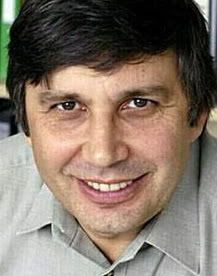siapa dia?
suprisingly muka dia terpampang dalam helaian kertas soalan untuk mid-term general physics hari tu.mau tak terkejut beruk kene describe fasal mamat nih.tapi nasib baiklah satu markah je kan?
nak dipendekkan cerita, baca artikel ini:
STOCKHOLM — Two Russian-born scientists shared the Nobel Prize in physics on Tuesday for groundbreaking experiments with the strongest and thinnest material known to mankind -- a potential building block for faster computers and lighter airplanes and satellites.
University of Manchester professors Andre Geim and Konstantin Novoselov used Scotch tape to isolate graphene, a form of carbon only one atom thick but more than 100 times stronger than steel, and showed it has exceptional properties, the Royal Swedish Academy of Sciences said.
Experiments with graphene could lead to the development of new superstrong and lightweight materials with which to make satellites, aircraft and cars, the academy said in announcing the 10 million kronor ($1.5 million) award.
The unique properties of the transparent material could also spur the development of innovative electronics, including transparent touch screens, more efficient computers and solar cells, although no commercial products have been created yet.
"It has all the potential to change your life in the same way that plastics did," Geim told The Associated Press on Tuesday. "It is really exciting."
Geim, 51, is a Dutch national while Novoselov, 36, holds both British and Russian citizenship. Both were born in Russia and started their careers in physics there. They first worked together in the Netherlands before moving to Britain, where they reported isolating graphene in 2004.
Novoselov is the youngest winner since 1973 of a prize that normally goes to scientists with decades of experience. The youngest Nobel laureate to date is Lawrence Bragg, who was 25 when he shared the physics award with his father William Bragg in 1915.
"It's a shock," Novoselov told the AP. "I started my day chatting over Skype over new developments -- it was quite unexpected."
Geim said he didn't expect to win the prize this year either and had forgotten that it was Nobel time when the prize committee called him from Stockholm.
The two scientists used simple Scotch tape as a crucial tool in their experiments, peeling off thin flakes of graphene from a piece of graphite, the stuff of pencil leads.
"It's a humble technique. But the hard work came later," Geim told the AP.
Paolo Radaelli, a physics professor at the University of Oxford, marveled at the simple methods the winners used.
"In this age of complexity, with machines like the super collider, they managed to get the Nobel using Scotch tape," Radaelli said.
Geim last year won the prestigious Korber European Science Award for the discovery, the University of Manchester said. He also won the "Ig nobel" prize in 2000 for making a frog levitate in a magnetic field. That award is handed out by the Annals of Improbable Research magazine for silly sounding scientific discoveries that often have surprisingly practical applications.
Phillip F. Schewe, spokesman for the American Institute of Physics in College Park, Maryland, said the Nobel to Geim and Novoselov was well-deserved.
"Graphene is the thinnest material in the world, it's one of the strongest, maybe the strongest material in the world. It's an excellent conductor. Electrons move through it very quickly, which is something you want to make circuits out of," Schewe said.
He said graphene may be a good material for making integrated circuits, small chips with millions of transistors that are the backbone of all modern telecommunications. Its properties could also lead to potential uses in construction material, Schewe said, but added it would take a while "before this sort of technology moves into mainstream application."
Lars Samuelson, a physics professor at the University of Lund, Sweden, said graphene developments are under way in several areas, especially for making TV screens.
"It is incredibly transparent, it lets through 98 per cent of light, so it would be ideal to have on large TV screens," he said.
The 2010 Nobel Prize announcements started Monday with the medicine award going to British researcher Robert Edwards, 85, for work that led to the first test tube baby. That achievement helped bring 4 million infants into the world so far and raised challenging new questions about human reproduction.
The chemistry prize will be announced Wednesday, followed by literature on Thursday, the peace prize on Friday and economics on Monday Oct. 11.
The prestigious awards were created by Swedish industrialist Alfred Nobel and first given out in 1901. The prizes are always handed out on Dec. 10, the anniversary of Nobel's death in 1896.
*credits to Sharene Ang *
*credits to Sharene Ang *

No comments:
Post a Comment